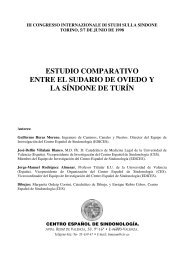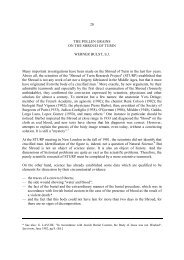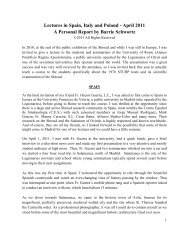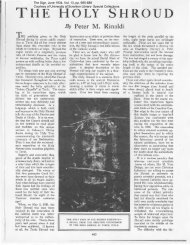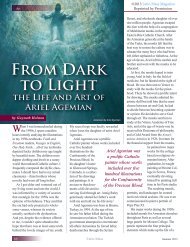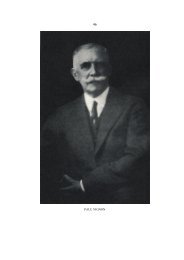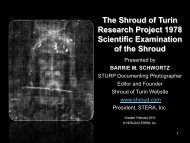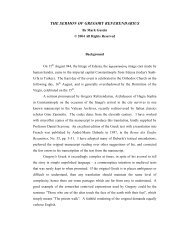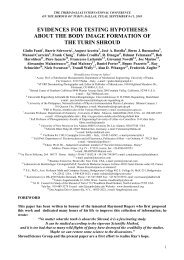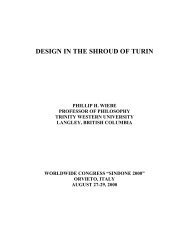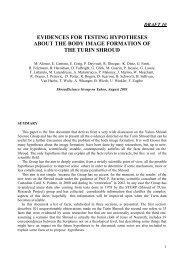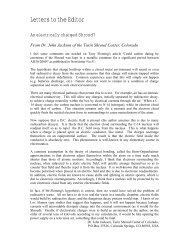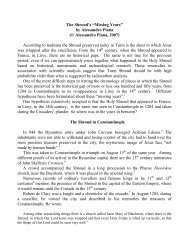BSTS Newsletter No. 74 - Part 8 - The Shroud of Turin Website
BSTS Newsletter No. 74 - Part 8 - The Shroud of Turin Website
BSTS Newsletter No. 74 - Part 8 - The Shroud of Turin Website
You also want an ePaper? Increase the reach of your titles
YUMPU automatically turns print PDFs into web optimized ePapers that Google loves.
Since I have the same book with Nicolotti’s quotation, even though in an edition from1998, I went to verify. And I have found that Zaccone’s thought continues in this way:“However, what the silence <strong>of</strong> the sources can mean in general terms and in our case deservesspecial attention, I will try to explain in these pages” 9 (9). Zaccone devotes 12 <strong>of</strong> the 19 pages<strong>of</strong> his text to the argument: “<strong>The</strong> prehistory: the <strong>Shroud</strong> in the first millennium?” In this text,towards the conclusion, he writes: “As I hope can be deduced from these few pages, surelythe historical problem <strong>of</strong> the <strong>Shroud</strong> is not solved. However, it is not correct to thinkconsequently that there is no possibility that the <strong>Shroud</strong> can go back to an age previous to themedieval one, based on a silence <strong>of</strong> the sources that, then, as we have seen, are not completelysilent at all. At the moment the historical studies on the <strong>Shroud</strong> are in a phase <strong>of</strong> development,even if until now it can be only asserted that from the strictly historical point <strong>of</strong> view definitiveelements do not exist either in order to assert a medieval origin or, least <strong>of</strong> all, in order toexclude a much more ancient origin” 10 (10) (italics in the original text).<strong>The</strong> essay finishes with these words: “What is important is to be able to maintain duerespect for all serious research, and a balanced detachment, aware that the great message thatthis cloth transmits to us has very little to do with the legitimate curiosity <strong>of</strong> knowingthoroughly its origins and vicissitudes” 11 (11).It seems to me that Zaccone’s thought appears in a very different way, reading what thereis after the phrase quoted by Nicolotti. <strong>The</strong>n I wanted to continue, reading again the pagesentitled: <strong>The</strong> <strong>Shroud</strong>: materials for an oriental history, that appear in the 2010 text 12 (12).Also here, towards the end, this specification is found: “As can be deduced from what hasbeen explained so far, we cannot have any certainty as to this first millennium, except the fact– in my opinion, important - that in the Christian world the news <strong>of</strong> the conservation <strong>of</strong>Christ’s burial equipment circulated very soon, and also <strong>of</strong> an image <strong>of</strong> him imprinted on alinen cloth, an image that, as already said in reference to a certain iconography <strong>of</strong> Edessa, iscomparable with that <strong>of</strong> the <strong>Shroud</strong>” 13 (13).Only his final affirmation, regarding iconographic research, has remained dark to me: “<strong>The</strong>research is surely interesting, but in my opinion is not definitive in this case either. However,it corroborates the conviction that the <strong>Shroud</strong>, as I have already said many times over, canrightly be thought to be the highest point <strong>of</strong> arrival <strong>of</strong> all the expectations about Christ’srepresentation” 14 (14), a concept that concludes also another <strong>of</strong> his recent contributions 15(15).<strong>The</strong> thesis <strong>of</strong> the <strong>Shroud</strong> as “the point <strong>of</strong> arrival <strong>of</strong> all the expectations about Christ’srepresentation” is not sustainable, because the research and the analyses carried out on therelic have excluded with absolute certainty every hypothesis <strong>of</strong> a fabrication with artisticmeans 16 (16) and Zaccone knows this because shortly before, he asserts: “<strong>The</strong> majority <strong>of</strong>9 G.M. ZACCONE, Storia e “preistoria” della Sindone, in G. Ghiberti – U. Casale, Dossier sulla Sindone,Queriniana, Brescia 1998, pp. 33-53, a p. 33.10 G.M. ZACCONE, op. cit. p. 50.11 G.M. ZACCONE, op. cit. p. 51.12 G.M. ZACCONE, op. cit. pp. 54-64.13 G.M. ZACCONE, op. cit. p. 63.14 G.M. ZACCONE, op. cit. p. 64.15 G.M. ZACCONE, Dalle acheropite alla Sindone, in Sacre impronte e oggetti «non fatti da mano d’uomo» nellereligioni, Atti del Convegno Internazionale, Torino 18-20 Maggio 2010, Ed. dell’Orso, Alessandria 2011, pp.309-323, on p. 323.16 J.H. HELLER - A.D ADLER, A Chemical Investigation <strong>of</strong> the <strong>Shroud</strong> <strong>of</strong> <strong>Turin</strong>, in Canadian Society <strong>of</strong> ForensicSciences Journal 14, 3 (1981), pp. 81-103; E.J. JUMPER et al., A Comprehensive Examination <strong>of</strong> the Various2
such studies, even if they do not explain the modalities <strong>of</strong> formation <strong>of</strong> the image, appear toexclude the manual origin, if compared with a dating result that would place the fabrication <strong>of</strong>the cloth in the medieval age” 17 (17). However, according to Zaccone, an ancient history <strong>of</strong>the <strong>Shroud</strong>, even if not sure, is possible, differently from what Nicolotti wanted to make himsay with the quotation <strong>of</strong> that isolated phrase.Proposing again Zaccone’s thought in an incomplete way made me go on with caution andattention in reading the rest <strong>of</strong> Nicolotti’s volume. Very soon I understood that I was reading ahandbook <strong>of</strong> negationism, than can be summed up mainly in these points:1. <strong>The</strong> Picard crusader Robert de Clari 18 in Saint Mary <strong>of</strong> Blachernae did not see the <strong>Shroud</strong>,but rather a silk veil, in front <strong>of</strong> an icon <strong>of</strong> the Virgin, than every Friday would have risenmiraculously. According to Nicolotti, the hypothesis that the <strong>Shroud</strong> disappeared duringthe sack <strong>of</strong> Constantinople <strong>of</strong> 1204 is “purely gratuitous” (CAP. I, p. 23).2. <strong>The</strong> Mandylion is not the <strong>Shroud</strong> because it was a small object described like a napkin todry the face, was found in the Pharos Chapel, was purchased by Louis IX and destroyed inParis during the French revolution; moreover, Jesus’ burial cloths, also in the Pharos, area different object from the Mandylion. On the possible Mandylion-<strong>Shroud</strong> identity,Nicolotti asserts: “<strong>The</strong> theory is both ingenious and incredible, and lacking incomparison”. <strong>The</strong> ignorance <strong>of</strong> the possessors with regard to the real dimensions <strong>of</strong> theMandylion is “one <strong>of</strong> the more eccentric conjectures” (CAP. I, pp. 21-23 and CAP. IV, p.125).3. In the testimonies <strong>of</strong> the trials against the Templars there are no references to the <strong>Shroud</strong>(CAP. II, pp. 28-71 and CAP. IV, pp. 100-104).4. <strong>The</strong> Templar seals do not have likenesses with the <strong>Shroud</strong> face (CAP. III, pp. 75-78).5. <strong>The</strong> face on the Templecombe panel has nothing to do with the <strong>Shroud</strong> face and the panelitself has nothing to do with the Templars (CAP. III, pp. 78-85).6. Codex Pray has nothing to do with the <strong>Shroud</strong> (CAP. III, pp. 85-88).7. <strong>The</strong> Chronicle <strong>of</strong> Saint-Denis has nothing to do with the <strong>Shroud</strong> (CAP. III, pp. 89-95).8. <strong>The</strong> <strong>Shroud</strong> was not in Athens because the Chartularium culisanense is false (CAP. IV,pp. 104-113), Nicholas <strong>of</strong> Otranto sees the bandages, not the <strong>Shroud</strong>, and he sees them inConstantinople, not elsewhere (CAP. IV, pp. 113-115), it cannot be asserted that Othon deLa Roche ever possessed it (CAP. IV, pp. 116-118).9. It cannot be said that the <strong>Shroud</strong> was in Ray-sur-Saône and Besançon (CAP. IV, pp. 118-120).10. <strong>The</strong>re is no relationship between the de La Roche family and Jeanne de Vergy; there isno pro<strong>of</strong> <strong>of</strong> the Othon de La Roche’s return to France; the measurements <strong>of</strong> the casket <strong>of</strong>Ray-sur-Saône have nothing to do with the fold marks on the <strong>Shroud</strong>, which in any casedo not mean anything (CAP. IV, pp. 120-123).11. <strong>The</strong>re is no relationship between Amaury de La Roche and Othon de La Roche; Amauryde La Roche never possessed the <strong>Shroud</strong> (CAP. IV, pp. 127-131).Stains and Images on the <strong>Shroud</strong> <strong>of</strong> <strong>Turin</strong>, in Archaeological Chemistry III, ACS Advances in Chemistry 205, 22(1984), pp. 447-476; L.A.SCHWALBE - R.N. ROGERS, Physics and Chemistry <strong>of</strong> the <strong>Shroud</strong> <strong>of</strong> <strong>Turin</strong>, A Summary<strong>of</strong> the 1978 Investigation, in Analytica Chimica Acta 135 (1982), pp. 3-49.17 G.M. ZACCONE, La Sindone, storia di un’immagine, quoted, p. 6.18 On page 17 Nicolotti writes that Robert de Clari is Flemish instead <strong>of</strong> Picard, but he corrects this mistake in thebook on the Mandylion on page 118. Barbara Frale made the same mistake. Did Nicolotti copy the mistake fromFrale’s books?3
12. <strong>The</strong> Templar Ge<strong>of</strong>froy de Charnay was not a relative <strong>of</strong> Ge<strong>of</strong>froy de Charny, the owner<strong>of</strong> the <strong>Shroud</strong> (CAP. IV, pp. 131-136).At this point, since it is obviously impossible to comment on the entire book, page by page,in the short space <strong>of</strong> a book review, the important point is to understand the method by whichthe various subjects are undertaken, to be able to draw the relative conclusions on the validity<strong>of</strong> the affirmations made by the author. I think, therefore, that it will be useful to quote, as anexample (and it is not the only one), another distorted quotation case, in order to understandhis way <strong>of</strong> proceeding. It concerns the dating <strong>of</strong> the Templecombe panel. But first we shouldsee what the panel is.During the Second World War, an interesting representation was found on an oak woodpanel in Templecombe, England. <strong>The</strong> locality owes its name to the fact that from 1185 till thebeginning <strong>of</strong> the 14 th century it was the site <strong>of</strong> a Templar preceptory 19 (19). On the panel abearded face appears, with faint contours. <strong>The</strong>re are no doubts that it represents Jesus: it isenough to confront it with the Santo Rostro 20 (20), a holy face from the 14 th century preservedin the Cathedral <strong>of</strong> Jaén, Spain (fig. 1). And it is unequivocally similar to the <strong>Shroud</strong>: with thetechnique <strong>of</strong> the overlay in polarized light 125 points <strong>of</strong> congruence between the two imageswere found 21 (21).Let us read now what the scientists who carried out the radiocarbon analysis write inArchaeometry 22 (22): “Two samples taken from the edges <strong>of</strong> two planks <strong>of</strong> a door with a<strong>Shroud</strong>-like image <strong>of</strong> Christ. <strong>The</strong> door was found on the site <strong>of</strong> a former Templar preceptoryat Templecombe in Somerset (Wilson 1986) […] <strong>The</strong> two sigma (95% confidence) range isAD 1280-1440. <strong>The</strong> dates are entirely compatible with the wood being cut in the period AD1280-1310, and thus the painting might be associated with the Knights Templar, perhapscommissioned prior to their suppression in 1307 by King Philip the Fair <strong>of</strong> France. On theother hand, a later date for the wood <strong>of</strong> up to around 1440 cannot be ruled out, whilst thepainting could <strong>of</strong> course have been executed much later than the timber on which it appears”.<strong>The</strong>refore the utility <strong>of</strong> the dating is not confirming the Templar attribution <strong>of</strong> the panel,something it obviously could not do, but not excluding it as the period <strong>of</strong> fabrication <strong>of</strong> theplank.Let us see now what Nicolotti writes: “Frale assures us that it was dated «to the years1275-1300», or «to 1280 approximately»” 23 (23), and mentions in a footnote the book byBarbara Frale 24 (24), a historian at the Vatican Secret Archives. In this footnote Nicolotti alsospecifies that “the date <strong>of</strong> 1280 appears on the inscription written by Frale and put beside thepanel during its exhibition in the royal palace <strong>of</strong> Venaria Reale from <strong>No</strong>vember 28, 2009 toApril 11, 2010” 25 (25). He continues as follows: “that - at least in a hypothetical way - couldbe compatible with the presence <strong>of</strong> the Templars in Templecombe before their arrest in 1308.For Emanuela Marinelli and Orazio Petrosillo, the plank was «dated to between the 12 th and19 I. WILSON, <strong>The</strong> <strong>Shroud</strong>. Fresh light on the 2000-year-old Mystery…, Transworld Publishers, London 2010, p.266.20 I. WILSON, Holy Faces, Secret Places, Doubleday, London 1991, p. 35.21 R. MORGAN, Testimonianza iconografica della Sindone in Inghilterra, in Le icone di Cristo e la Sindone,edited by L. COPPINI and F. CAVAZZUTI, Ed. San Paolo, Cinisello Balsamo (MI) 2000, pp. 189-194, on pp. 193-194.22 R.E.M. HEDGES et al., Radiocarbon dates <strong>of</strong> the Oxford AMS system: Archaeometry datelist 6, inArchaeometry 29, 2 (1987), pp. 289-306, on p. 303.23 A. NICOLOTTI, op. cit. p. 81.24 B. FRALE, La sindone di Gesù Nazareno, Il Mulino, Bologna 2009, p. 63.25 A. NICOLOTTI, op. cit. p. 157.4
the 14 th century»” 26 (26), and in a footnote he mentions the “Marinelli-Petrosillo” book,inverting the names and omitting the subtitle Storia di un enigma 27 (27). But what is moreamazing is the continuation <strong>of</strong> his footnote: “For the books <strong>of</strong> Emanuela Marinelli, here isPier Angelo Gramaglia’s statement: «To the general public, the Catholic publishers prefer tosupply pitiful substitutes rather than give space to works <strong>of</strong> serene and objective criticism»” 28(28). Apart from the gratuitous insult, this is surely enlightening on Nicolotti’s ways <strong>of</strong>expressing himself, it is ridiculous to speak about “Catholic publishers”, after having quoted apublication by Rizzoli, one <strong>of</strong> the greatest Italian lay publishers.Nicolotti does not explain who Pier Angelo Gramaglia is: he is a <strong>Turin</strong>ese Catholicpatrologist, strongly against the authenticity <strong>of</strong> the <strong>Shroud</strong>, who in the past published on thesubject, besides two articles in a historical magazine, two booklets (in 1978 and 1981) for thepublishing house Claudiana, at that time exclusively Waldensian. <strong>The</strong> name Claudiana is inhomage to the bishop Claudius <strong>of</strong> <strong>Turin</strong> (8 th – 9 th century), considered a “forerunner” <strong>of</strong> theWaldensians for his fight against the introduction <strong>of</strong> sacred images in churches and for hisactivity as a commentator on the Bible.Gramaglia is highly esteemed by Nicolotti for his affirmations, to which he makesreference many times in his book on the Mandylion; to the readers <strong>of</strong> the book on theTemplars, however, he limits himself to supplying only another footnote quotation to what hehimself says <strong>of</strong> the countess Maria Grazia Siliato’s books: “<strong>The</strong>y are for the most partconfusing and patch up stuff that can only be imagined” 29 (29). In another footnote he adds:“Pier Angelo Gramaglia has described the content <strong>of</strong> Ms Siliato’s books, that he defines as «aself-styled Swiss archaeologist», as a «true encyclopaedia <strong>of</strong> nonsense». <strong>The</strong> judgment is notvery delicate, but the substance is thus” 30 (30). I think that all comment is superfluous.But let us go back to the issue <strong>of</strong> the Templecombe panel. Nicolotti’s text continues asfollows: “By now the reader will be accustomed to such confusion, and perhaps he will notfeel further astonishment when he discovers that this information, already conflicting in itself,is all false too” 31 (31).After having quoted the corrected date, he comments: “This simply means that the 12 thcentury <strong>of</strong> Marinelli-Petrosillo does not exist, that the interval 1275-1300 <strong>of</strong> Frale iscompletely wrong and all the more so is “1280 approximately” - the latter data was repeatedby Baima Bollone 32 (32) in his latest book. <strong>The</strong> sindonologists, in conclusion, keep silent withregard to the 14 th and 15 th centuries, and not by chance: <strong>of</strong> the 160 years interval proposed bythe radiometric dating, in fact, only the first 27 coincide with the Templar presence inTemplecombe, while the central value falls around 1360, when the preceptory had been in thehands <strong>of</strong> the Hospitallers for thirty years and the <strong>Shroud</strong> had already been exhibited inFrance” 33 (33).26 A. NICOLOTTI, op. cit. p. 81.27 O. PETROSILLO – E. MARINELLI, La Sindone. Storia di un enigma, Rizzoli, Milano 1998.28 A. NICOLOTTI, op. cit. p. 157.29 A. NICOLOTTI, op. cit. p. 128.30 A. NICOLOTTI, op. cit. p. 168.31 A. NICOLOTTI, op. cit. p. 81.32 Nicolotti does not supply information on Pierluigi Baima Bollone, who is a pr<strong>of</strong>essor <strong>of</strong> Forensic Medicine atthe University <strong>of</strong> <strong>Turin</strong> and for many years was the scientific director <strong>of</strong> the International Center <strong>of</strong> Sindonology<strong>of</strong> <strong>Turin</strong>.33 A. NICOLOTTI, op. cit. p. 81.5
In this passionate tirade, Nicolotti does not notice that he accuses sindonologists <strong>of</strong> keepingsilent also about the 14 th century, when a few lines previously he reproached Marinelli andPetrosillo for having supplied the date 12 th -14 th century; however, since I am one <strong>of</strong> the twoaccused, I can easily explain from where the “false information” was born. <strong>The</strong> period shiftderives from the source used, a book by historian Ian Wilson 34 (34), in which it is read thatbased on the dating, the panel could go back to 1280. Wilson evidently referred to the openingdate <strong>of</strong> the interval; thinking instead that he had indicated, by that date, the central point <strong>of</strong> theinterval, and being 1280 in the 13 th century, I concluded that the panel went back to the 12 th -14 th century. That’s all. <strong>The</strong> accusation <strong>of</strong> deliberately counterfeiting the date, therefore, isunjustified.Quoting Archaeometry, however, Nicolotti, who wants to deny the possibility that thepanel represents the <strong>Shroud</strong> face and belonged to the Templars, avoids saying that in thearticle it is admitted that the image <strong>of</strong> the panel resembles the <strong>Shroud</strong>, that the panel wasfound on the site <strong>of</strong> a Templar preceptory and that the painting can be associated to theTemplars. Moreover, he emphasizes that the panel could originally have been “a shutter, adoor, a fence, a cover” and adds that “someone could have re-used it to paint, for any reason,in a successive moment. If he made it in Templecombe or elsewhere, it is impossible toknow” 35 (35).Another example <strong>of</strong> quotation instrumentally used by Nicolotti concerns a phrase <strong>of</strong> his asa comment on the quarrel between Frale, who in the description <strong>of</strong> the worship <strong>of</strong> themysterious idol by a Templar reads signum fustanium (cotton burlap) 36 (36), and himself, whoinstead reads signum fusteum (wooden image) 37 (37). I shall not enter into this issue, I onlynote that Nicolotti immediately afterwards writes: “<strong>The</strong> reading is not difficult, and it isshared by all those who have seen the manuscript”. In a footnote to this affirmation 38 (38),Nicolotti attributes to Simonetta Cerrini an article that in fact is by the journalist BernadetteArnaud 39 (39), in which Cerrini is only interviewed; and on the issue <strong>of</strong> the signum fusteum hethus attributes to Cerrini what is not in inverted commas, and therefore was written byArnaud.It is likely that Arnaud refers to the thought <strong>of</strong> Cerrini, but the quotation as it is is notcorrect. This footnote is the only reference to Cerrini in Nicolotti’s book, who does not saythat the scholar <strong>of</strong> the Templars is a historian who graduated at the Sorbonne in Paris; and hedoes not even say that in this interview she admits the hypothesis that the Templars couldhave venerated the <strong>Shroud</strong>.After trying, by all means, to eliminate a placing, inconvenient for him, <strong>of</strong> theTemplecombe panel in space and the time, Nicolotti proceeds with the attempt to destroy theiconographic argument, defined as “the last and weakest”, mocking sindonologists: “<strong>The</strong>yswear that the panel represents the face <strong>of</strong> Christ, and what’s more in a form that, asEmanuela Marinelli and Ilaria Ramelli 40 assure, is «unequivocally» similar to the <strong>Shroud</strong>” 4134 I. WILSON, <strong>The</strong> Blood and the <strong>Shroud</strong>, <strong>The</strong> Free Press, New York, USA 1998, p. 136.35 A. NICOLOTTI, op. cit. p. 82.36 B. FRALE, I Templari e la sindone di Cristo, Il Mulino, Bologna 2009, p. 81.37 A. NICOLOTTI, op. cit. p. 60.38 A. NICOLOTTI, op. cit. p. 152.39 B. ARNAUD Bernadette, Le Temple adorait-il le saint suaire?, Sciences et Avenir n. 761, Juillet 2010, p. 58,box in her article Les derniers jours des Templiers, pp. 48-61,40 Nicolotti does not supply any information on me. But he does not even say that Ilaria Ramelli holds a doctoratein Philology and Literature <strong>of</strong> the classical world.6
(41). <strong>The</strong> irony <strong>of</strong> Nicolotti is moved then on Alan Whanger, «a psychiatrist» who works withhis wife, who “has took part in the making <strong>of</strong> a documentary on the <strong>Shroud</strong> published by anAmerican creationist association” and “examining some photographs <strong>of</strong> the <strong>Shroud</strong>, thoughthe could identify on it the trace <strong>of</strong> various instruments <strong>of</strong> Christ’s passion” 42 (42). And he liststhem.Nicolotti should be glad at the fact that Whanger is a psychiatrist and works with his wife,since in his book on the Mandylion he speaks in favour <strong>of</strong> Gaetano Ciccone, an Italianpsychiatrist, and <strong>of</strong> his wife: “I thank them for the gift <strong>of</strong> their book, for some suggestions andthe shipment <strong>of</strong> bibliographical material” 43 (43). However, in order to complete theinformation that Nicolotti does not supply, Whanger taught at the Duke University MedicalCenter in Durham (<strong>No</strong>rth Carolina, USA) and is also specialized in surgery, geriatrics andtropical medicine. From 1961 to 1965 Whanger and his wife, who belong to the MethodistChurch, were missionaries in Zimbabwe.This thoroughness <strong>of</strong> information is necessary, if we want to give an idea <strong>of</strong> a person’svalue, and it seems to me that Nicolotti is lacking also in this. It would be as if I, who praisehim for the immense size <strong>of</strong> the work he has carried out, instead <strong>of</strong> saying that he is ahistorian from the University <strong>of</strong> <strong>Turin</strong>, simply mocked him because he has written that theman <strong>of</strong> the <strong>Shroud</strong> “has a large moustache under the nose and immediately under the lowerlip” 44 (44) and that the “purple cloak that Jesus carried to the Golgotha” 45 is acknowledgedalso on some Templar seals, while in Matthew 27:31 and in Mark 15:20 we can read that theyput Jesus’ clothes on him to lead him away to Calvary.Personally the identification <strong>of</strong> the imprints <strong>of</strong> the objects, that the Whangers think theycan see, does not convince me, but this has nothing to do with the technique <strong>of</strong> the overlay inpolarized light, published in Applied Optics 46 (46). Nicolotti asks these questions: “Really 125points, on a single face? Identified with which criteria?” 47 (47). It astonishes me that abloodhound like him, who succeeds in re-examining ancient manuscripts, has not read thearticle in Applied Optics. However, he could have at least read the article published by theWhangers in Italian in a book on icons 48 (48).“Without taking advantage <strong>of</strong> who knows which technique - Nicolotti continues - Iperceive there many meaningful divergences”. And he lists them. But his objections regardingthe differences between the face on the <strong>Shroud</strong> and that <strong>of</strong> Templecombe, with open mouthand eyes, do not take into account the observation <strong>of</strong> the <strong>Shroud</strong> as it is, where in effect itcould seem to show an open mouth and eyes; it is the photographic negative that reveals thatthey are closed. <strong>The</strong> lack <strong>of</strong> the blood and the lesions are not meaningful either: many otherholy faces <strong>of</strong> Jesus exist, inspired by the <strong>Shroud</strong>, that are amended from the signs <strong>of</strong> thesuffering. It is enough to think <strong>of</strong> the icon <strong>of</strong> the Holy Mandylion (14 th century) <strong>of</strong> theTretyakov Gallery <strong>of</strong> Moscow (fig. 2).41 A. NICOLOTTI, op. cit. p. 82.42 A. NICOLOTTI, op. cit. pp. 82-83.43 A. NICOLOTTI, Dal Mandylion di Edessa alla Sindone di Torino. Metamorfosi di una leggenda, quoted, p. 4.44 A. NICOLOTTI, op. cit. p. 82.45 A. NICOLOTTI, op. cit. p. 76.46 A.D. WHANGER - M. WHANGER, Polarized image overlay technique: a new image comparison method and itsapplications, in Applied Optics 24, 6, (1985), pp. 766-772.47 A. NICOLOTTI, op. cit. p. 82.48 A.D. WHANGER, Icone e Sindone. Confronto mediante tecnica di polarizzazione di immagine sovrapposta(Polarized Image Overlay Technique: PIOT), in Le icone di Cristo e la Sindone, cit., pp. 145-151.7
Nicolotti’s tirade then increases the tone: “Where are, then, these 125 points <strong>of</strong>coincidence? <strong>The</strong> tip <strong>of</strong> the nose <strong>of</strong> the first portrait fits together with the tip <strong>of</strong> the nose <strong>of</strong> thesecond?” 49 (49). And he attacks Whanger, “who is accustomed to identifying astonishingamounts <strong>of</strong> congruence points between the <strong>Shroud</strong> and several objects (he marked 145 and188 with two Roman coins, and even 250 with the icon <strong>of</strong> the Pantocrator <strong>of</strong> St. Catherine onthe Sinai)” 50 (50). Apart from the fact that the coins were not Roman but Byzantine 51 (51), thecritics <strong>of</strong> other scholars’ works would have written in a different tone. But we will return tothis argument when we comment on the other book, on the Mandylion.Concerning the Templecombe face, Nicolotti assumes that it could also represent the head<strong>of</strong> Saint John the Baptist and concludes: “It cannot be excluded that it is one <strong>of</strong> the severaltypologies <strong>of</strong> the Veronica portrait, or a face <strong>of</strong> whatever, painted as an exercise by whateverpainter on the first disused panel that came to his hand” 52 (52). In conclusion, it can beanything, except a face that resembles the <strong>Shroud</strong>.Regarding the testimonies drawn from the confessions <strong>of</strong> the Templars, personally I thinkthat it is very difficult to deduce anything sure from them, as they were extorted under torture;however, some it is worth trying to search for interesting indications, provided that,obviously, the examination <strong>of</strong> what is asserted is done in the proper way.In his attack against Frale, accused <strong>of</strong> text manipulation, Nicolotti writes: “This way <strong>of</strong>dealing with the confessions, rejecting what is thought as false and maintaining what isconsidered credible, is based on an arbitrary prejudice that does not find, inside the samedepositions, any reason. In this way we can make a source say what it is desired, without anycontrol, by means <strong>of</strong> the removal <strong>of</strong> the disliked or conflicting aspects” 53 (53).<strong>The</strong>n, the public notary <strong>of</strong> the process <strong>of</strong> Arnaut Sabbatier hears lignum and writes lineum“because <strong>of</strong> simple assonance between the two words” 54 (54), and the same Sabbatier instead<strong>of</strong> kissing the feet <strong>of</strong> the idol, kisses those <strong>of</strong> the support on which it rests 55 (55). Nicolotti hadalready written “it is not said that the feet belong to the idol” 56 (56). Well, the public notarywas a bit deaf, but why must the Templar kiss the pedestal instead <strong>of</strong> the idol? Jean d’Anisywas right to complain that there was not enough light 57 (57).<strong>The</strong>n Nicolotti reports a passage drawn from the Chronicle <strong>of</strong> Saint-Denis: “In fact, soonafter, they started to adore a false idol, and certainly this idol was an old skin as if allembalmed and like smooth burlap, and in this the Templar certainly placed his most miserablefaith and believes, and believed very firmly” 58 (58). Criticizing Frale, who translates “this idolwas made <strong>of</strong> a very ancient human skin, that appeared embalmed, or in the form <strong>of</strong> pureburlap” 59 (59), and therefore makes you think that there are two different idols, Nicolottiwrites: “It is therefore the same object: a head <strong>of</strong> embalmed human skin (or spread withbalsams or ointments) that appeared like a smooth burlap (or glossy, because <strong>of</strong> the presence49 A. NICOLOTTI, op. cit. p. 82.50 A. NICOLOTTI, op. cit. p. 83.51 Afterwards Nicolotti must have noticed the mistake and in the book on the Mandylion, pp. 164-167, speaksabout Byzantine coins.52 A. NICOLOTTI, op. cit. p. 85.53 A. NICOLOTTI, op. cit. p. 48.54 A. NICOLOTTI, op. cit. p. 56.55 A. NICOLOTTI, op. cit. p. 58.56 A. NICOLOTTI, op. cit. p. 52.57 A. NICOLOTTI, op. cit. p. 38.58 A. NICOLOTTI, op. cit. p. 90.59 B. FRALE, I Templari e la sindone di Cristo, quoted, p. 84.8
<strong>of</strong> the balsams)” 60 (60). If it had been Frale who introduced the word “head” in a descriptionwhere it was not present, Nicolotti would have been infuriated. But evidently he can do it,while others cannot.We then see the case <strong>of</strong> the Chartularium culisanense, a diplomatic code destroyed duringthe Second World War. In 1980 61 (61) it was found again in Naples, in the church <strong>of</strong> S.Catherine in Formiello, a nineteenth-century transcription <strong>of</strong> some sheets <strong>of</strong> the Chartulariumand a paper was presented about it by the discoverer, Pasquale Rinaldi, in the conference thatwas held in Bologna the next year 62 (62). <strong>The</strong> interest lies in the fact that on one <strong>of</strong> thesesheets there is a letter attributed to <strong>The</strong>odore Angelus Comnenus, who in 1205 63 (63) wrote toPope Innocent III in order to complain, among other things, that “the Sheet in which our LordJesus Christ was wrapped, after the death and before the Resurrection” had been taken fromConstantinople to Athens.Nicolotti criticizes Daniel Scavone, a historian from the University <strong>of</strong> Southern Indiana,who thinks the letter <strong>of</strong> the Chartularium is credible: “Daniel Scavone, in order to defend thecredibility <strong>of</strong> the letter, points out that a modern history handbook <strong>of</strong> the crusades designates<strong>The</strong>odore as «Angelus Comnenus»; moreover, he thinks it possible that <strong>The</strong>odoreintentionally wrote to the Pope signing «Angelus» because «that name could have beenreceived more favourably» than Ducas, and «was decidedly more popular in the West»because <strong>of</strong> the good relationships he enjoyed with Alexius IV Angelus. <strong>The</strong> first explanationis completely lacking in historical value, the second simply imaginative” 64 (64). Scavone’shypothesis that the <strong>Shroud</strong> was brought to France by Pons de Chaponay is branded byNicolotti as “the fruit <strong>of</strong> imaginative inductions” that “do not even have pro<strong>of</strong> to supportthem” 65 (65).Since the Chartularium is controversial, Nicolotti passes from the doubt to the certainty <strong>of</strong>its falsity, citing the opinion <strong>of</strong> two authoritative Byzantinists, Luca Pieralli and Otto Kresten,who have communicated this to him in private correspondence with these words: “It is a latecounterfeiting and <strong>of</strong> low level, surely put in the center <strong>of</strong> the scientific discussion on the<strong>Shroud</strong> by the enthusiasm <strong>of</strong> some churchman in good faith” 66 (66). But even admitting it is afake, in any case the question would remain: why does the counterfeiter mention just Athens?I think that it would be interesting to look closer at this point, but Nicolotti thinks differentlyand limits himself to adding that Zaccone, like Karlheinz Dietz and Emmanuel Poulle, “didnot seem too persuaded by its authenticity” 67 (67).But a photograph <strong>of</strong> that transcription <strong>of</strong> the letter still is exposed in <strong>Turin</strong> at the Museum<strong>of</strong> the <strong>Shroud</strong>, <strong>of</strong> which Zaccone is director. Moreover, since he recommends Zaccone’s book60 A. NICOLOTTI, op. cit. p. 91.61 On page 106 <strong>of</strong> his book, I Templari e la Sindone, storia di un falso, quoted, due to a mistake, Nicolotti writesthat the nineteenth-century copies were found in 1982.62 P. RINALDI, Un documento probante sulla localizzazione in Atene della santa Sindone dopo il saccheggio diCostantinopoli, in: La Sindone, scienza e fede, Atti del II Convegno Nazionale di Sindonologia, Bologna, 27-29novembre 1981, CLUEB, Bologna 1983, pp. 109-113.63 On page 116 <strong>of</strong> his book, I Templari e la Sindone, storia di un falso, quoted, due to a typing mistake, Nicolottiwrites 1025 instead <strong>of</strong> 1205.64 A. NICOLOTTI, op. cit. p. 163.65 A. NICOLOTTI, op. cit. p. 119.66 A. NICOLOTTI, op. cit. p. 111.67 A. NICOLOTTI, op. cit. p. 109. Nicolotti writes <strong>of</strong> Poulle (recently deceased) that he is a medieval historian onpage 170, while he does not supply information on Dietz, who is pr<strong>of</strong>essor <strong>of</strong> Ancient History at the University <strong>of</strong>Würzburg (Germany).9
as “the best and most updated essay”, he could also quote what the author writes: “Such asource would be surely interesting, even if it introduces dark implications and shadows thatare not easy to dissipate. I refer in particular to its tradition - nineteenth-century transcription -but also to its nature. In fact, in origin it was part <strong>of</strong> a cartulary, on whose typology thedoctrine expresses very discordant judgments. It is sure, however, that the impossibility <strong>of</strong> theexamination <strong>of</strong> the extrinsic characters <strong>of</strong> the document is objectively a limit. I think,however, that there could be some interpolations in it. Among other things, it seems to me, asan example, that the intitulatio, in which the author <strong>The</strong>odore Comneno Ducas defineshimself «<strong>The</strong>odore Angelus», does not correspond to the title used by the family in thatperiod, while, on the contrary, it is completely correct that the title <strong>of</strong> Despot <strong>of</strong> Epirus is notattributed to his brother, as it would be anachronistic for that age. Regarding the historicalcontent <strong>of</strong> the document, it seems to me that it can be asserted that it becomes partly harmonicin the context <strong>of</strong> the reactions to the excesses <strong>of</strong> the Crusaders in Constantinople, that just inthat arc <strong>of</strong> time also provoked the intervention <strong>of</strong> Innocent III” 68 (68). <strong>The</strong>refore, it could beworthwhile trying to obtain a deeper analysis <strong>of</strong> the origin <strong>of</strong> the Chartularium.Naturally, then, since for Nicolotti it is sure that Otho de La Roche never possessed the<strong>Shroud</strong> 69 (69), there is no pro<strong>of</strong> <strong>of</strong> his return to France 70 (70) and the <strong>Shroud</strong> <strong>of</strong> Besançon is“quite a late fake” 71 (71), he then ridicules the “arranged theories, that are contrived in orderto save this and that”. And he continues: “According to Alessandro Piana 72 (72), for example,Otho would have taken the true <strong>Shroud</strong> (<strong>of</strong> <strong>Turin</strong>) to France and from it he would have drawna copy to give to the archbishop (<strong>of</strong> Besançon). As usual, the documents are lacking: it wasenough for Piana to find a painted <strong>Shroud</strong> in the castle <strong>of</strong> Ray-sur-Saône in order to imaginethat the family that inhabited it was also in charge <strong>of</strong> the fabrication <strong>of</strong> the Besançon <strong>Shroud</strong>”73 (73).In fact Piana did not state anything as a certainty, he spoke about “a new clue” in support<strong>of</strong> the “most probable hypothesis” <strong>74</strong> (<strong>74</strong>). Nicolotti, after having specified that the foldsargument is “pseudo-reasoning” 75 (75), maintains that Piana wishes to push by force the<strong>Shroud</strong> refolded into 48 layers into a casket that is too small: “It is enough to imagine that therefolded sheet has been a bit pressed within the box and forced to enter in it, Piana says” 76(76).We read Piana’s text for comparison: “<strong>The</strong> dimensions <strong>of</strong> the casket are too small for the<strong>Shroud</strong> refolded into 48, it is therefore probable that the Cloth was positioned inside likely68 G.M. ZACCONE, La Sindone, storia di un’immagine, quoted, pp. 62-63.69 A. NICOLOTTI, op. cit. p. 118.70 A. NICOLOTTI, op. cit. p. 121.71 A. NICOLOTTI, op. cit. p. 118.72 Nicolotti does not supply information on Alessandro Piana, who is a biologist, author <strong>of</strong> historical publications.See <strong>Shroud</strong> <strong>Newsletter</strong> 65, June 2007, pp. 6-7 and <strong>Shroud</strong> <strong>Newsletter</strong> 66, December 2007, pp. 9-31; A. PIANA“Missing years” <strong>of</strong> the Holy <strong>Shroud</strong>, in Proceedings <strong>of</strong> the International Workshop on the Scientific approach tothe Acheiropoietos Images, Frascati 4-6 May 2010, a cura di P. DI LAZZARO, Ed. ENEA, Frascati (Roma) 2010,pp. 95-102.73 A. NICOLOTTI, op. cit. p. 119.<strong>74</strong> A. PIANA, Sindone, gli anni perduti. Da Constantinople a Lirey: nuove prove, Sugarco Edizioni, Milano 2007,p. 65.75 A. NICOLOTTI, I Templari e la Sindone, storia di un falso, quoted, p. 122. Nicolotti quotes the invitation <strong>of</strong> thetextile expert Mechthild Flury-Lemberg “not to give an inadequate weight to the presence <strong>of</strong> these folds” and infootnote p. 167 he reminds us that the <strong>Shroud</strong> remained rolled up for centuries on a cylinder until “1993”, whichshould be 1998. In the book on the Mandylion on p. 47 he indicates 1998 correctly.76 A. NICOLOTTI, op. cit. p. 123.10
practicing a light distortion regarding the folding obtained” 77 (77). Forced, here, there is onlyNicolotti’s thought, who on the several proposed theories to explain the arrival <strong>of</strong> the <strong>Shroud</strong>in France, comments: “In the absence <strong>of</strong> serious historical pro<strong>of</strong>, the sindonologists haveheaped up non-verified hypotheses, gratuitous deductions and apodictic affirmations <strong>of</strong>tenbased on material and also rough errors” 78 (78).Another enlightening example <strong>of</strong> the way Nicolotti argues is his description <strong>of</strong> arepresentation, <strong>of</strong>ten cited by the sindonologists, and his reasons for asserting that it hasnothing to do with the <strong>Shroud</strong>. This is the miniature in Codex Pray in the National Library <strong>of</strong>Budapest (fig. 3 on the right) that goes back to 1192-1195 79 (79) and can be compared with ananalogous miniature in the contemporary Psalter <strong>of</strong> Ingeborg (fig. 3 on the left).In the upper scene <strong>of</strong> the folio 28r <strong>of</strong> Codex Pray we can see the unction <strong>of</strong> Christ laid outafter the crucifixion on a sheet. <strong>The</strong> inspiration from the <strong>Shroud</strong> is obvious (fig. 4): the bodyis completely naked and the hands cross to cover the lower abdomen. <strong>The</strong> thumbs are notvisible. On the forehead there is a sign that recalls the analogous trickle <strong>of</strong> blood that isobserved on the <strong>Shroud</strong>.To Nicolotti “the attempts at transforming that drawing into a representation <strong>of</strong> the <strong>Shroud</strong>are inconceivable” 80 (80). His objections are that: “<strong>The</strong> sheet is unrolled in the sense <strong>of</strong> thewidth”; “the man <strong>of</strong> the <strong>Shroud</strong> crosses the hands, not the forearms”; “it is enough then to turnthe page in order to see the resurrected Christ with all the fingers”; the sign on the forehead“appears like an indistinct spot”; “and it does not even surprise the sindonologists that on thebody <strong>of</strong> Jesus and on the sheet the wounds from the nails, the flagellum and the lance arelacking, that on the <strong>Shroud</strong> are rendered so obvious by the bloodstains”. <strong>The</strong> interpretations <strong>of</strong>the sindonologists, to Nicolotti, are “exercises in fantasy” 81 (81).Clearly the artist has represented, in a stylized way, the details that struck him; neither canit be expected that, in representing the resurrected Christ, he had to continue to keep himholding the bent thumbs. In the Psalter <strong>of</strong> Ingeborg the sign on the forehead is replaced by atuft, as it is observed in many icons; and the sheet is so long that it falls back on the shoulders<strong>of</strong> the two men at the head and the feet <strong>of</strong> Jesus. In Codex Pray Nicolotti also sees that “part<strong>of</strong> the cloth falls back on the shoulders <strong>of</strong> Joseph” 82 (82), but this observation is alsomistaken, because in this case he is confusing the <strong>Shroud</strong> with the dresses <strong>of</strong> the twopersonages.In the lower scene we see the arrival <strong>of</strong> the pious women at the sepulchre, and the angelshowing them the empty shroud. According to Nicolotti, instead, “the angel indicates with thehand a sarcophagus whose cover has been removed and overlapped in diagonal, with a burialcloth over it” 83 (83). If this were so, under it we could notice the cavity <strong>of</strong> the empty sepulchrelike in the Psalter <strong>of</strong> Ingeborg; but Nicolotti thinks that the sarcophagus <strong>of</strong> Codex Pray has“two stones” 84 (84). I have never seen a sarcophagus with two covers.Still in the lower scene <strong>of</strong> Codex Pray, the upper part <strong>of</strong> the empty sheet has a drawing thatimitates the fishbone weaves structure <strong>of</strong> the <strong>Shroud</strong>, while small red crosses cover the lower77 A. PIANA, op. cit. p. 69.78 A. NICOLOTTI, op. cit. p. 127.79 A.M. DUBARLE, L’icona del “Manoscritto Pray”, in Le icone di Cristo e la Sindone, pp. 181-188.80 A. NICOLOTTI, op. cit. p. 86.81 A. NICOLOTTI, op. cit. pp. 87-88.82 A. NICOLOTTI, op. cit. p. 86.83 A. NICOLOTTI, op. cit. p. 87.84 A. NICOLOTTI, op. cit. p. 88.11
did wrap the body, so why is the action <strong>of</strong> winding a problem? On the third point, if thebandages were still in Constantinople or not, according to Nicolotti the text does not authorizeScavone to think that the bandages are not in Constantinople any more when the abbot writes.Nicolotti does not say that Scavone’s translation is wrong, but that “it is difficult”. Scavoneassumes that the abbot, when he says that he saw bandages “later on”, saw them elsewhere,more specifically in Athens during a stage <strong>of</strong> his journey; Nicolotti thinks that the abbot sawthe bandages in Constantinople. But Scavone 95 (95) formulates a hypothesis, Nicolotti speaks<strong>of</strong> certainties.At this point it is evident that Nicolotti does not start from a neutral position and this, in thecourse <strong>of</strong> his surveying, is harmful to his interpretation <strong>of</strong> the text and the validity <strong>of</strong> hisconclusions. A necessary reflection prevails: if “we cannot have any certainty relative to thisfirst millennium”, as Zaccone, a scholar thought reliable by Nicolotti, warned, then how canthe same Nicolotti have these total negationist certainties, given as unquestionable? How canhe silence those sources that, according to Zaccone, “are not completely silent”? Here,Nicolotti’s method is thus: if a document is controversial, then it is false. If a document isauthentic, then what it is written in it is false. If what is written is true, it cannot refer to the<strong>Shroud</strong> that is now in <strong>Turin</strong>.In the end Nicolotti, convinced that he has swept away all and everybody, asserts: “<strong>The</strong>result <strong>of</strong> the historical analysis, on the whole, is extremely disappointing: <strong>of</strong> all the inferringcastle <strong>of</strong> the publications that have been taken under investigation, not a stone has resisted thesieve <strong>of</strong> critical examination. Approximations, errors, anachronisms, false sources, misleadingdemonstrations and «adventurous deductions» are accompanied by real counterfeit texts”.Shortly afterwards he writes: “This book, consequently, has assumed the features <strong>of</strong> a resolutewiping the slate clean with a sponge”. Moreover he adds that “the Catholic Church, withprecaution, has <strong>of</strong>ficially chosen not to call the <strong>Shroud</strong> a «relic» anymore” 96 (96), while on thecontrary Pope Benedict XVI defines it as a relic in his recent book “Jesus <strong>of</strong> Nazareth”, parttwo 97 (97).Nicolotti continues complaining about “dilettantish, inaccurate and partisan studies, whichmutually feed themselves and support themselves”. And again: “<strong>The</strong> winning din <strong>of</strong> thepseudoinvestigators comes out on top, imitating the language <strong>of</strong> historians without knowingor sharing their methodology, and they do not hesitate to resort to any type <strong>of</strong> contrivedargument in order to support their own theses”. And so on with the “pseudoscientific drift”,the “propagandistic, ideological, political or trade operation”, the “resistant culture, diffuseand shared, founded on the unreliable 98 ” (98).Among the evils <strong>of</strong> the “last times”, Nicolotti stigmatizes these: “Unbridled freedom <strong>of</strong>conjecture, confusion between hypothesis and certainty, abandonment <strong>of</strong> the logical criteria <strong>of</strong>the pro<strong>of</strong>, neglect in the use <strong>of</strong> sources and incautious resource to literature <strong>of</strong> second or third95 D. SCAVONE, Documenting the <strong>Shroud</strong>’s missing years, in Proceedings <strong>of</strong> the International Workshop on theScientific approach to the Acheiropoietos Images, pp. 87-94; D. SCAVONE, <strong>The</strong> <strong>Shroud</strong> <strong>of</strong> <strong>Turin</strong> inConstantinople, the documentary evidence, Sindon Nuova Serie, Quaderno n. 1, Giugno 1989, pp. 113-128.Besançon and other hypotheses for the missing years, in: <strong>The</strong> <strong>Shroud</strong> <strong>of</strong> <strong>Turin</strong>, Perspectives on a MultifacetedEnigma, Proceedings <strong>of</strong> the 2008 Columbus International Conference, August 14-17, 2008, Edizioni LibreriaProgetto, Padova 2009, pp. 408-433.96 A. NICOLOTTI, op. cit. p. 137.97 J. RATZINGER - BENEDETTO XVI, Gesù di Nazaret - seconda parte. Dall’ingresso in Gerusalemme fino allarisurrezione, Libreria Editrice Vaticana 2011, p. 254.98 A. NICOLOTTI, op. cit. p. 138.13
hand”. <strong>The</strong>refore he invokes the historians as “pr<strong>of</strong>essionals <strong>of</strong> the refutation” 99 (99). Andhere is the final appeal: “<strong>The</strong> control, the punctilious verification, the insistence on themethod and the sensitization with regard to the topic <strong>of</strong> the corrected spreading are bindingand sometimes frustrating efforts, but certainly necessary and in some manner also foreboding<strong>of</strong> satisfactions. Otherwise, the more and more real risk is that sooner or later the rigor <strong>of</strong> thehistorical method must be forced irremediably to give way to - and not only outside <strong>of</strong> theturris eburnea <strong>of</strong> the Academy - the arrogant strut <strong>of</strong> a made-up fake” 100 (100).It is a real pity that a scholar, so rigorous in the research <strong>of</strong> the sources, is then sounbalanced in an overcritical way in their interpretation. <strong>The</strong> reading <strong>of</strong> his works hasrevealed them to me like the sum <strong>of</strong> extreme negationism: Nicolotti is against any possibilitythat there could be any minimal historical indication that the <strong>Shroud</strong> existed before the 14 thcentury and this conviction <strong>of</strong> his is not proposed as an alternative hypothesis to others, but asabsolute certainty. This is in evident contrast with the sources recalled by Zaccone, that “arenot completely silent”.But the <strong>Shroud</strong> has suffered much more in its history, and its authenticity cannot be wipedaway by a sponge that tries to eliminate the traces <strong>of</strong> its records. Even if it is a sponge soakedin vinegar.99 A. NICOLOTTI, I Templari e la Sindone, storia di un falso, quoted, p. 138.100 A. NICOLOTTI, I Templari e la Sindone, storia di un falso, quoted, pp. 138-139.14



